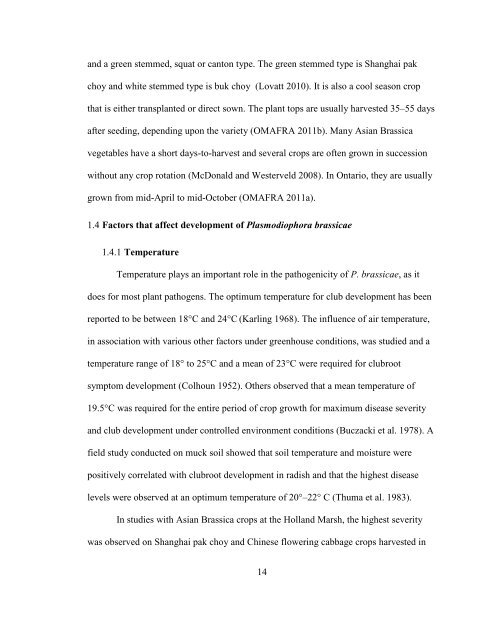Hema Kasinathan Thesis May 1 2012.pdf - Atrium - University of ...
Hema Kasinathan Thesis May 1 2012.pdf - Atrium - University of ...
Hema Kasinathan Thesis May 1 2012.pdf - Atrium - University of ...
You also want an ePaper? Increase the reach of your titles
YUMPU automatically turns print PDFs into web optimized ePapers that Google loves.
and a green stemmed, squat or canton type. The green stemmed type is Shanghai pakchoy and white stemmed type is buk choy (Lovatt 2010). It is also a cool season cropthat is either transplanted or direct sown. The plant tops are usually harvested 35–55 daysafter seeding, depending upon the variety (OMAFRA 2011b). Many Asian Brassicavegetables have a short days-to-harvest and several crops are <strong>of</strong>ten grown in successionwithout any crop rotation (McDonald and Westerveld 2008). In Ontario, they are usuallygrown from mid-April to mid-October (OMAFRA 2011a).1.4 Factors that affect development <strong>of</strong> Plasmodiophora brassicae1.4.1 TemperatureTemperature plays an important role in the pathogenicity <strong>of</strong> P. brassicae, as itdoes for most plant pathogens. The optimum temperature for club development has beenreported to be between 18°C and 24°C (Karling 1968). The influence <strong>of</strong> air temperature,in association with various other factors under greenhouse conditions, was studied and atemperature range <strong>of</strong> 18° to 25°C and a mean <strong>of</strong> 23°C were required for clubrootsymptom development (Colhoun 1952). Others observed that a mean temperature <strong>of</strong>19.5°C was required for the entire period <strong>of</strong> crop growth for maximum disease severityand club development under controlled environment conditions (Buczacki et al. 1978). Afield study conducted on muck soil showed that soil temperature and moisture werepositively correlated with clubroot development in radish and that the highest diseaselevels were observed at an optimum temperature <strong>of</strong> 20°–22° C (Thuma et al. 1983).In studies with Asian Brassica crops at the Holland Marsh, the highest severitywas observed on Shanghai pak choy and Chinese flowering cabbage crops harvested in14
















